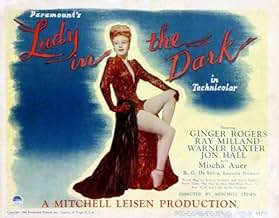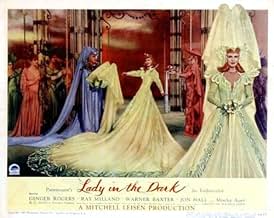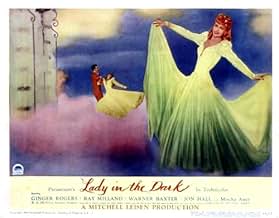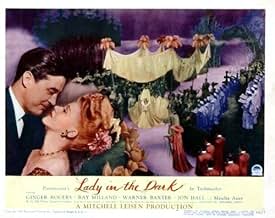CALIFICACIÓN DE IMDb
5.9/10
605
TU CALIFICACIÓN
Agrega una trama en tu idiomaLiza Elliott, "Allure" magazines editor-in-chief, suffers from headaches and continuous daydreams and undergoes psychoanalysis to determine why.Liza Elliott, "Allure" magazines editor-in-chief, suffers from headaches and continuous daydreams and undergoes psychoanalysis to determine why.Liza Elliott, "Allure" magazines editor-in-chief, suffers from headaches and continuous daydreams and undergoes psychoanalysis to determine why.
- Dirección
- Guionistas
- Elenco
- Nominado a 3 premios Óscar
- 1 premio ganado y 3 nominaciones en total
Opiniones destacadas
I found this to be moderately enjoyable and much smoother than I was expecting, after reading of all the problems in making it and the cutting of musical numbers from the original score. Would love to see it as was originally intended (in a restored DVD version).
The psychoanalysis as it unfolds is interesting and makes sense, except to the point of the woman needing to be dominated by the man. I don't know if this was dictated by the culture of the time, but all that was really needed was for Liza to know she needed to give time to gaining fulfillment in a relationship (without the aspect of dominance) and not be so driven work wise (her substitute), and it would have come out without the nasty taste it leaves now (in regards to this aspect of the film).
Director Mitchell Leisen dealt with this sort of theme also (without the psychoanalysis) in Take a Letter Darling which was funnier and sharper, and without the need for the man to have to dominate the woman.
Some of the visual imagery in the dream sequences is a lot of fun and apparently a lot of care was put into their production.
As well the movie seems like it is a 50s product but that could just be the colour.
The psychoanalysis as it unfolds is interesting and makes sense, except to the point of the woman needing to be dominated by the man. I don't know if this was dictated by the culture of the time, but all that was really needed was for Liza to know she needed to give time to gaining fulfillment in a relationship (without the aspect of dominance) and not be so driven work wise (her substitute), and it would have come out without the nasty taste it leaves now (in regards to this aspect of the film).
Director Mitchell Leisen dealt with this sort of theme also (without the psychoanalysis) in Take a Letter Darling which was funnier and sharper, and without the need for the man to have to dominate the woman.
Some of the visual imagery in the dream sequences is a lot of fun and apparently a lot of care was put into their production.
As well the movie seems like it is a 50s product but that could just be the colour.
A Technicolor spectacular, with costumes and wonderful sets to match, but the story isn't much, mostly what you might expect to read in Popular Psychoanalysis magazine.
Best are the dream and reverie sequences, especially the trial in the circus ring. These are where the singing and dancing is, but there is not much and what little there is is not very exciting.
Best are the dream and reverie sequences, especially the trial in the circus ring. These are where the singing and dancing is, but there is not much and what little there is is not very exciting.
I won't criticize much because I really like everything that Ginger Rogers does, yet somehow I get the feeling about this film, "there should have been more." At least I think more could have been done with the story.
Also, it brings to mind her later film, "It had to be You" which is a similar, comedic journey into the subconscious layers of the mind, obviously a popular topic of the day.
Ray Milland is in fine form here and I consider it one of his best roles.
The scenes are beautifully presented, very stagey at times with actors seemingly going through the motions, but the artistry of the settings and gowns is impeccable. All in all it's meant as light entertainment and ought to be viewed in that manner. Wish the video was available too.
Also, it brings to mind her later film, "It had to be You" which is a similar, comedic journey into the subconscious layers of the mind, obviously a popular topic of the day.
Ray Milland is in fine form here and I consider it one of his best roles.
The scenes are beautifully presented, very stagey at times with actors seemingly going through the motions, but the artistry of the settings and gowns is impeccable. All in all it's meant as light entertainment and ought to be viewed in that manner. Wish the video was available too.
The lady is in the 'dark' about being a lesbian. Oh why can't somebody just say it. I guess you could on Broadway and with Gertrude Lawrence in 1940 but at Paramount in '44 with Ginger, well, she just had to stay in the dark and have repressed sexual dreams about her fur in a cage and her eggs at a circus (see the Jenny number) ... and see that dress she unfurls.. a vagina representation of ever I saw one on a movie screen that wasn't x rated. In this ultra glamorous dreamy musical film Ginger is a business woman in business attire (read: lesbian .....) and she is tormented between her real business and society's demands that she marry and be with a man. Hence dilemma, dreams and fur openings and the egg circus (see the Jenny number) ... the storyline demands she relate to a man when she does not want to hence the dream sequences of antagonism and sexual wonderings. Ray Milland is the sop she is deemed to marry when anyone from this century can see she really wants to stay in a women's world and stop being a frustrated big angry prowling pussy in a cage (see the Jenny number) .... Kurt Weill knew what he was on about and so do we... but Paramount, in masking it for the masses in '44 pushed the pussycat into the fantasy sequences, hired a gay director and let loose on the dreams and shot the lot in the best most stylish Technicolor you ever saw outside of YOLANDA AND THE THIEF and THE PIRATE. In this according to Paramount, all Ginger needed was a jolly good roger.... ing.....
"Lady in the Dark" is a curiosity. The circus sequence with "The Saga of Jenny" gives a taste of what the movie version of the Broadway show might have been like (as other commentators have noted, the song is the sole survivor of the Broadway score by Weill and Gershwin, aside from snatches of "My Ship" and "Suddenly it's Spring", and a verse from "Once Life to Life" which Ginger Rogers recites). Ginger is a knockout, even in her "plain" business suits. The visual design is so rich you could swim in it- it was lovely to see the 40s magazine design as well as the sets. And the costumes! The sequin lined mink skirt is stunning, and so is the gown in the wedding sequence. The psychoanalysis storyline is well handled for a movie made in this period when analysis was strange and frightening to the audience. However, what could have been an exquisite soufflé is let down by the bizarre decision to cut all but one of the numbers and the development of the plot. It suggests that women are miserable in business suits and are far happier wearing frou frou gowns and being "dominated" by men (its terminology, not mine). I will say in the plot's defense (if I may take Ray Milland's part in the circus sequence for a moment) that it doesn't have Ginger pairing off with irresistible but insecure movie star Randy Curtis. When she announced that she was going to marry him and give up her job I yelled out, "You'll be sorry!" The writers recognize that Randy and staying home to be a housewife (even a Hollywood one) would bore Ginger's character out of her tree. Her sparring colleague is a far better choice, and there's a hint in the final that perhaps neither Ray or Ginger will dominate the other, but be partners in running the magazine (they're both overwhelmed with enthusiasm for it). But this hint of equality isn't enough to redeem Ray's earlier nastiness to Ginger, or the tone of misogyny. The movie still comes down with a thud, like Ginger at the end when Ray takes her chair.
¿Sabías que…?
- TriviaThis was one of the first films to use the word "sex." Ray Milland says, "Rage is a pretty good substitute for sex, isn't it?"
- Citas
Russell Paxton: "This is the end! The absolute end!"
- Créditos curiososAt the start of the film the Paramount logo is set at night, in the dark.
At the end of the film the Paramount logo is seen at dawn, come into the light.
- ConexionesReferenced in Libros Famosos (1946)
- Bandas sonorasMain Title
Music by James Jimmy Van Heusen and Lyrics by Johnny Burke
Performed by the Paramount Studio Orchestra and Chorus
Selecciones populares
Inicia sesión para calificar y agrega a la lista de videos para obtener recomendaciones personalizadas
- How long is Lady in the Dark?Con tecnología de Alexa
Detalles
- Fecha de lanzamiento
- País de origen
- Idioma
- También se conoce como
- Lady in the Dark
- Locaciones de filmación
- Productora
- Ver más créditos de la compañía en IMDbPro
- Tiempo de ejecución1 hora 40 minutos
- Relación de aspecto
- 1.37 : 1
Contribuir a esta página
Sugiere una edición o agrega el contenido que falta

Principales brechas de datos
By what name was La que supo amar (1944) officially released in India in English?
Responda


































